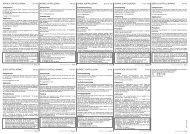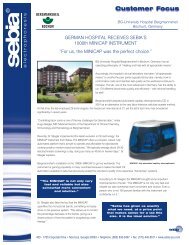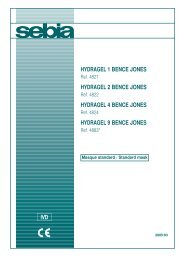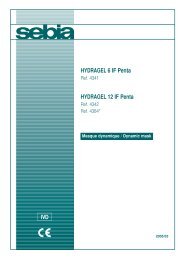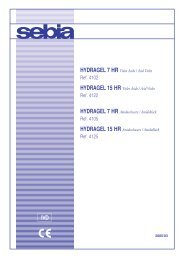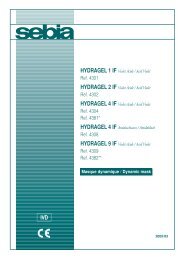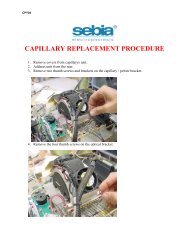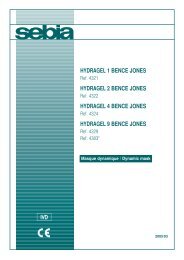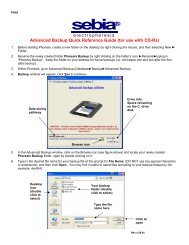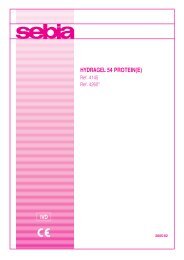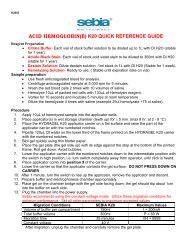CAPILLARYS HEMOGLOBIN(E)
CAPILLARYS HEMOGLOBIN(E) - Sebia Electrophoresis
CAPILLARYS HEMOGLOBIN(E) - Sebia Electrophoresis
- No tags were found...
Create successful ePaper yourself
Turn your PDF publications into a flip-book with our unique Google optimized e-Paper software.
<strong>CAPILLARYS</strong> <strong>HEMOGLOBIN</strong>(E) - 2010/10<br />
Patterns are automatically adjusted with regard to Hb F fraction to facilitate their interpretation:<br />
- when Hb F fraction is not detected on an electrophoretic pattern, a yellow warning signal appears, the adjustment is then performed using the<br />
position of the Hb F fraction on the two previous patterns obtained with the same capillary ;<br />
- when the adjustment is not possible, a red warning signal appears, Hb A, Hb F and Hb A2 fractions are then not identified (Call SEBIA).<br />
In those two cases, the different variant zones (C1 to C12) do not appear neither on the screen of the system, nor on the ticket result.<br />
PLEASE CAREFULLY READ THE <strong>CAPILLARYS</strong> INSTRUCTION MANUAL.<br />
III. END OF ANALYSIS SEQUENCE<br />
At the end of each analysis sequence, the operator must initiate the "stand by" or "shut down" procedure of the <strong>CAPILLARYS</strong> system in order to store<br />
capillaries in optimal conditions.<br />
IV. FILLING OF REAGENT CONTAINERS<br />
The <strong>CAPILLARYS</strong> system has a reagent automatic control.<br />
IMPORTANT: Please refer to the instructions for replacement of reagent containers respecting color code for vials and connectors.<br />
A message will be displayed when it is necessary to perform one of the following tasks:<br />
• Place a new buffer container and / or;<br />
• Fill the container with working wash solution and / or;<br />
• Fill the container with filtered distilled or deionized water for rinsing capillaries and / or;<br />
• Empty the waste container.<br />
WARNING: Do not use marketed deionized water, such as water for ironing for example (risk of important capillaries damage). Use only<br />
water with ultrapure quality, such as injection grade water.<br />
IMPORTANT: Before filling the rinse container, it is recommended to wash it with plenty of distilled or deionized water.<br />
PLEASE CAREFULLY READ THE <strong>CAPILLARYS</strong> INSTRUCTION MANUAL.<br />
QUALITY CONTROL<br />
After having changed the analysis buffer vial (even if the lot number is unchanged) or the technique, after a capillary cleaning sequence<br />
with CAPICLEAN or after capillaries activation and before starting a new analysis sequence, it is necessary to run two analysis sequences with<br />
the Hb AF Control, SEBIA, PN 4777, and the sample rack No. 0 intended for control blood sample (see paragraph REAGENTS REQUIRED BUT NOT<br />
SUPPLIED).<br />
It is also advised to include into each run of samples, an assayed control blood (for example, a blood sample containing hemoglobins A, F, C and S,<br />
such as Hb AFSC Control, SEBIA, PN 4792, or the Hb AF Control, SEBIA, PN 4777).<br />
* US customers: Follow federal, state and local guidelines for quality control.<br />
RESULTS<br />
Values<br />
Direct detection at 415 nm in capillaries yields relative concentrations (percentages) of individual hemoglobin zones.<br />
Interpretation<br />
See ELECTROPHORETIC PATTERNS, figures 1 - 8.<br />
The different migration zones of hemoglobin variants (called C1 to C12) are shown on the screen of the system and on the result ticket. Passing the<br />
mouse cursor over a zone name displays icon information containing possible hemoglobin variants that could be seen in this zone.<br />
For each fraction, the maximum position defines the migration zone.<br />
See the table showing the potential variants located in each zone.<br />
WARNING: The graduation of the horizontal axis does not allow, in any case, the identification of an hemoglobin variant.<br />
1. Qualitative abnormalities: Hemoglobinopathies<br />
Most hemoglobinopathies are due to substitution by mutation of a single amino acid in one of the four types of polypeptide chains (1, 2, 4, 9, 12) . The clinical<br />
significance of such a change depends on the type of amino acid and the site involved (13) . In clinically significant disease, either the α-chain or the<br />
ß-chain is affected.<br />
More than 900 variants of adult hemoglobin have been described (6, 14) . The first abnormal hemoglobins studied and the most frequent have an altered<br />
net electric charge, leading to an easy detection by electrophoresis.<br />
There are five main abnormal hemoglobins which present a particular clinical interest: S, C, E, O-Arab and D.<br />
The <strong>CAPILLARYS</strong> CORD BLOOD procedure is intended for the identification of hemoglobinopathies and alpha-thalassemias.<br />
Hemoglobin S<br />
Hemoglobin S is the most frequent. It is due to the substitution of one glutamic acid (an acidic amino acid No. 6) of the ß-chain by a valine (a neutral<br />
amino acid): when compared to Hb A, its isoelectric point is elevated and its total negative charge decreased with the analysis pH.<br />
Its electrophoretic mobility is therefore increased in the capillary and this hemoglobin is faster than A and F fractions. With the alkaline buffered<br />
<strong>CAPILLARYS</strong> CORD BLOOD procedure, hemoglobin S migrates before A and F fractions.<br />
- 62 -



